SSC211: Analysis of Social Science Research Methods Report
VerifiedAdded on 2022/08/14
|8
|1821
|24
Report
AI Summary
This report analyzes a research study on perceptions of Singapore's heritage and landmarks, employing both quantitative and qualitative research methods. The study involved focused group discussions at heritage sites (qualitative) and a survey method (quantitative) to collect data on participant perceptions, knowledge, and memories of the sites. The report discusses the research design, including non-experimental processes and face-to-face interviews, highlighting the use of questionnaires for data collection and numerical interpretation. The analysis focuses on how the study enhances validity through actions like assessing knowledge, memories, physical appeal, and the importance of sites. The report identifies weaknesses, such as the influence of personal experiences and site popularity on survey results, and suggests improvements like employing experimental or control group approaches and using structured questions. References to key research methods and related literature are also provided.
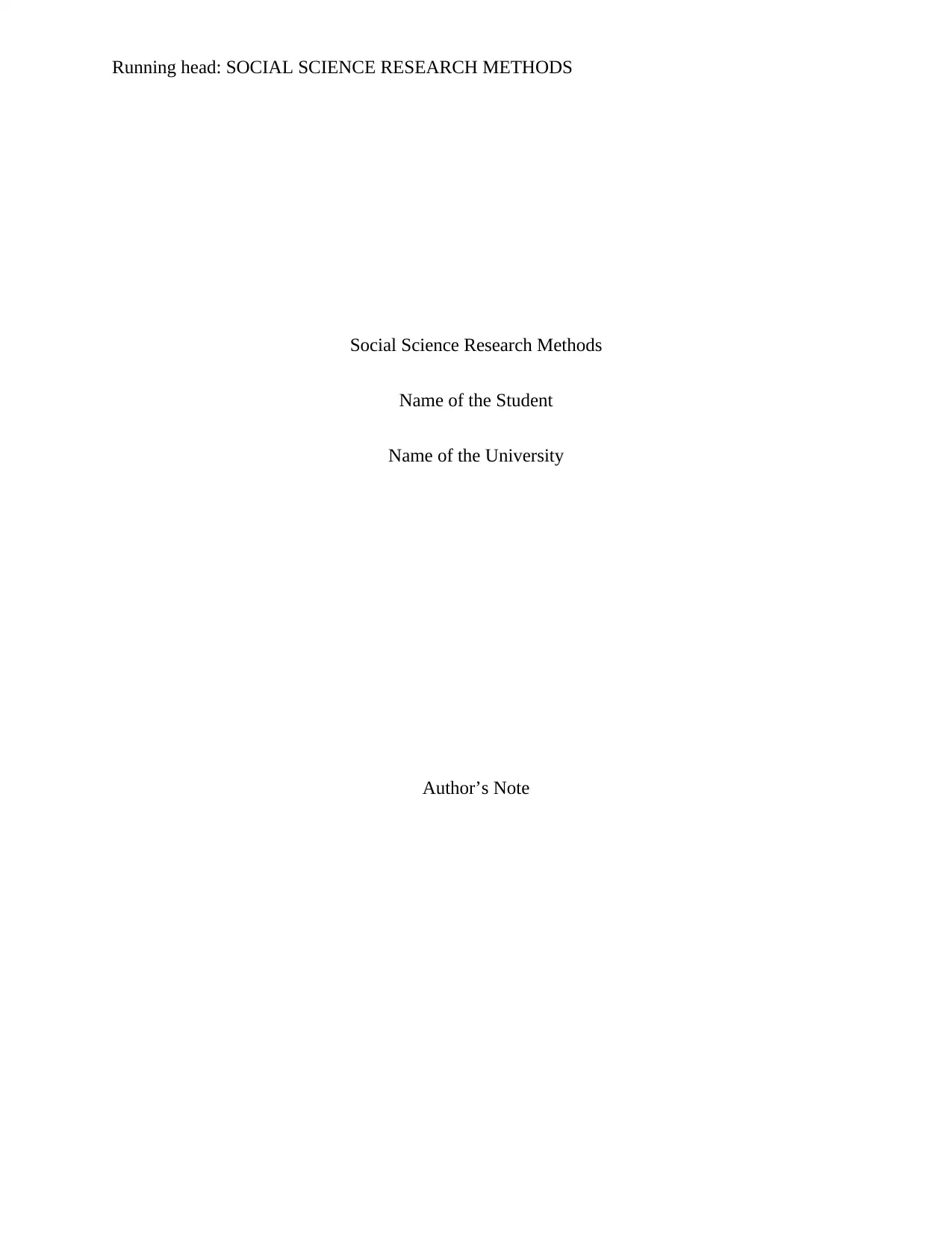
Running head: SOCIAL SCIENCE RESEARCH METHODS
Social Science Research Methods
Name of the Student
Name of the University
Author’s Note
Social Science Research Methods
Name of the Student
Name of the University
Author’s Note
Paraphrase This Document
Need a fresh take? Get an instant paraphrase of this document with our AI Paraphraser
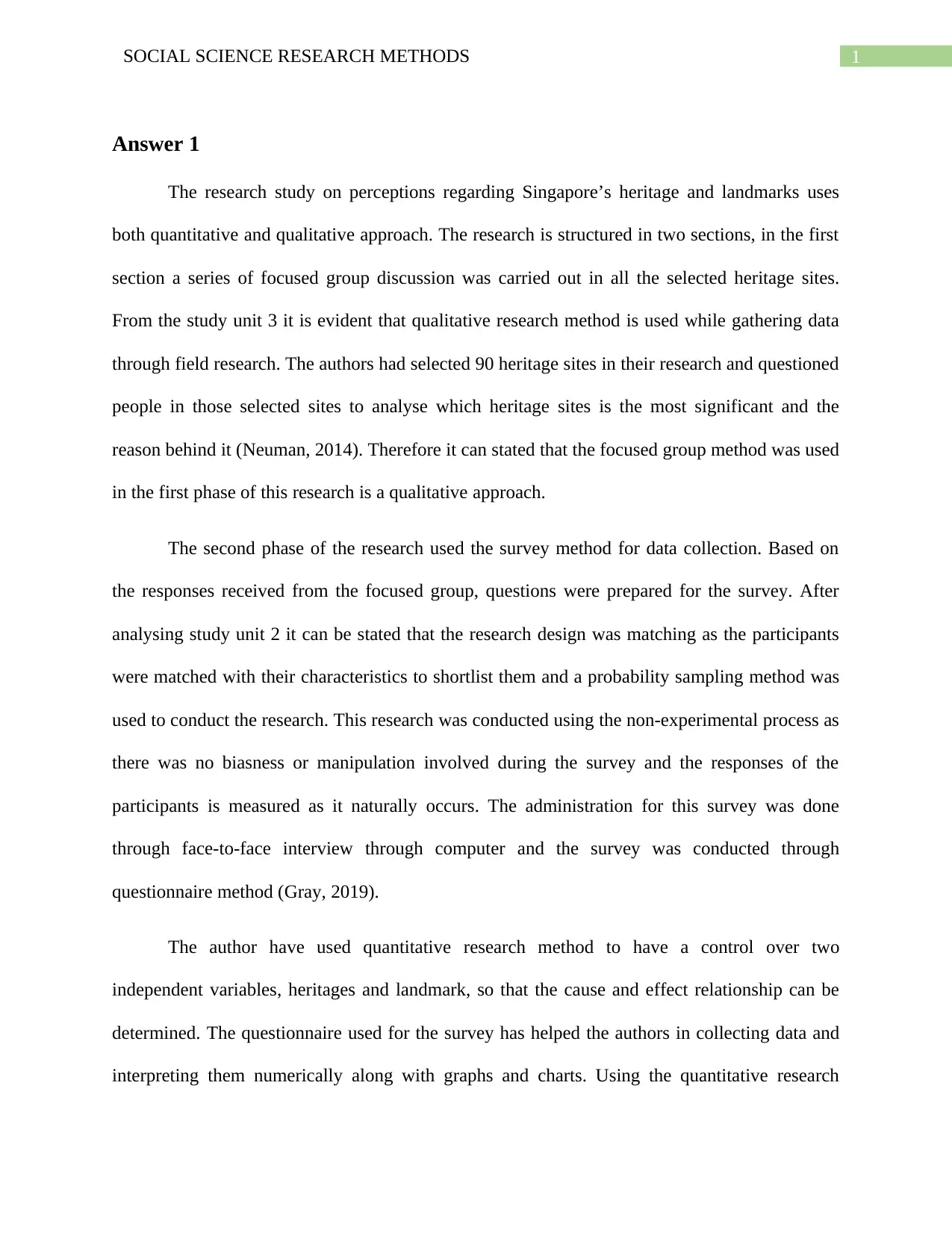
1SOCIAL SCIENCE RESEARCH METHODS
Answer 1
The research study on perceptions regarding Singapore’s heritage and landmarks uses
both quantitative and qualitative approach. The research is structured in two sections, in the first
section a series of focused group discussion was carried out in all the selected heritage sites.
From the study unit 3 it is evident that qualitative research method is used while gathering data
through field research. The authors had selected 90 heritage sites in their research and questioned
people in those selected sites to analyse which heritage sites is the most significant and the
reason behind it (Neuman, 2014). Therefore it can stated that the focused group method was used
in the first phase of this research is a qualitative approach.
The second phase of the research used the survey method for data collection. Based on
the responses received from the focused group, questions were prepared for the survey. After
analysing study unit 2 it can be stated that the research design was matching as the participants
were matched with their characteristics to shortlist them and a probability sampling method was
used to conduct the research. This research was conducted using the non-experimental process as
there was no biasness or manipulation involved during the survey and the responses of the
participants is measured as it naturally occurs. The administration for this survey was done
through face-to-face interview through computer and the survey was conducted through
questionnaire method (Gray, 2019).
The author have used quantitative research method to have a control over two
independent variables, heritages and landmark, so that the cause and effect relationship can be
determined. The questionnaire used for the survey has helped the authors in collecting data and
interpreting them numerically along with graphs and charts. Using the quantitative research
Answer 1
The research study on perceptions regarding Singapore’s heritage and landmarks uses
both quantitative and qualitative approach. The research is structured in two sections, in the first
section a series of focused group discussion was carried out in all the selected heritage sites.
From the study unit 3 it is evident that qualitative research method is used while gathering data
through field research. The authors had selected 90 heritage sites in their research and questioned
people in those selected sites to analyse which heritage sites is the most significant and the
reason behind it (Neuman, 2014). Therefore it can stated that the focused group method was used
in the first phase of this research is a qualitative approach.
The second phase of the research used the survey method for data collection. Based on
the responses received from the focused group, questions were prepared for the survey. After
analysing study unit 2 it can be stated that the research design was matching as the participants
were matched with their characteristics to shortlist them and a probability sampling method was
used to conduct the research. This research was conducted using the non-experimental process as
there was no biasness or manipulation involved during the survey and the responses of the
participants is measured as it naturally occurs. The administration for this survey was done
through face-to-face interview through computer and the survey was conducted through
questionnaire method (Gray, 2019).
The author have used quantitative research method to have a control over two
independent variables, heritages and landmark, so that the cause and effect relationship can be
determined. The questionnaire used for the survey has helped the authors in collecting data and
interpreting them numerically along with graphs and charts. Using the quantitative research
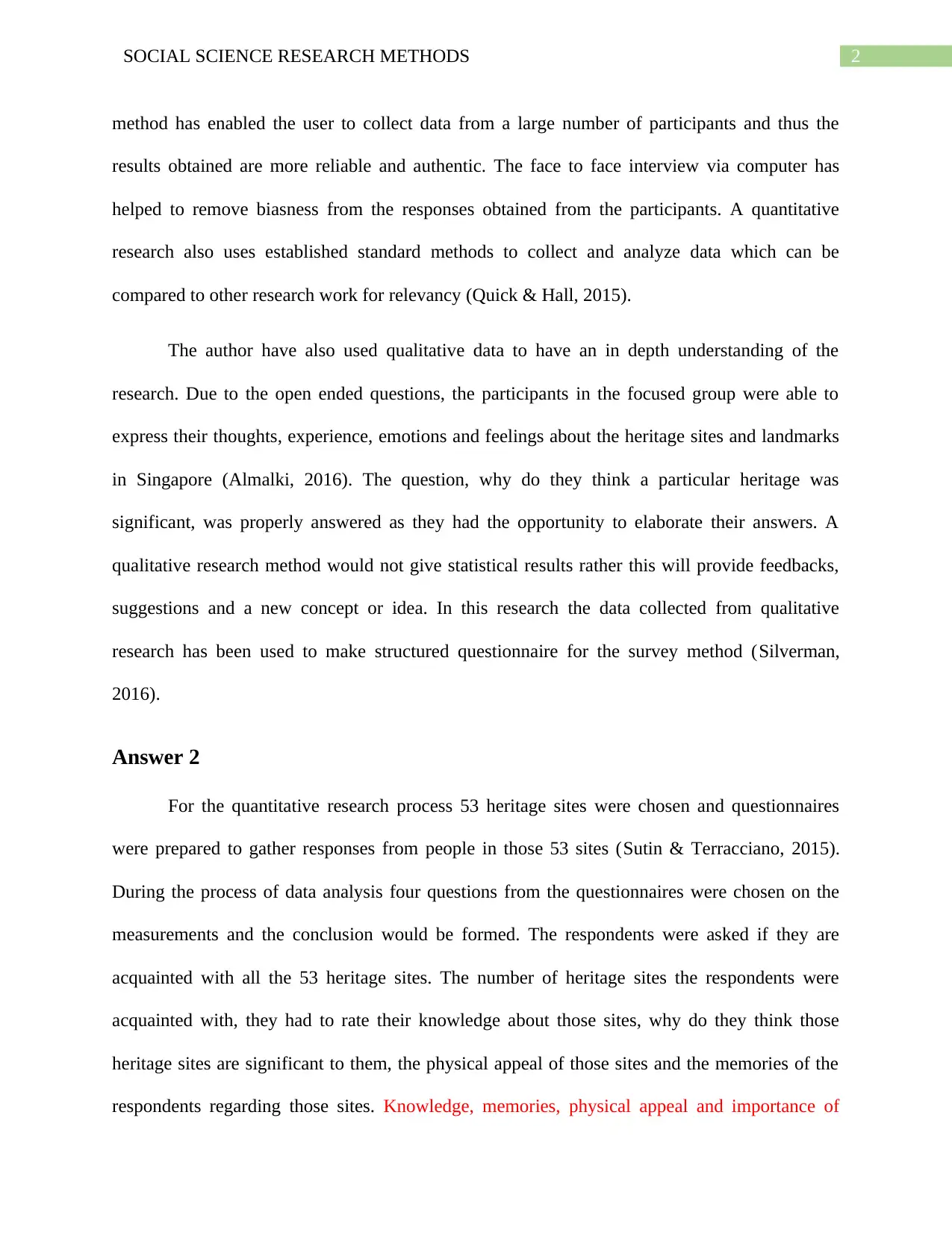
2SOCIAL SCIENCE RESEARCH METHODS
method has enabled the user to collect data from a large number of participants and thus the
results obtained are more reliable and authentic. The face to face interview via computer has
helped to remove biasness from the responses obtained from the participants. A quantitative
research also uses established standard methods to collect and analyze data which can be
compared to other research work for relevancy (Quick & Hall, 2015).
The author have also used qualitative data to have an in depth understanding of the
research. Due to the open ended questions, the participants in the focused group were able to
express their thoughts, experience, emotions and feelings about the heritage sites and landmarks
in Singapore (Almalki, 2016). The question, why do they think a particular heritage was
significant, was properly answered as they had the opportunity to elaborate their answers. A
qualitative research method would not give statistical results rather this will provide feedbacks,
suggestions and a new concept or idea. In this research the data collected from qualitative
research has been used to make structured questionnaire for the survey method (Silverman,
2016).
Answer 2
For the quantitative research process 53 heritage sites were chosen and questionnaires
were prepared to gather responses from people in those 53 sites (Sutin & Terracciano, 2015).
During the process of data analysis four questions from the questionnaires were chosen on the
measurements and the conclusion would be formed. The respondents were asked if they are
acquainted with all the 53 heritage sites. The number of heritage sites the respondents were
acquainted with, they had to rate their knowledge about those sites, why do they think those
heritage sites are significant to them, the physical appeal of those sites and the memories of the
respondents regarding those sites. Knowledge, memories, physical appeal and importance of
method has enabled the user to collect data from a large number of participants and thus the
results obtained are more reliable and authentic. The face to face interview via computer has
helped to remove biasness from the responses obtained from the participants. A quantitative
research also uses established standard methods to collect and analyze data which can be
compared to other research work for relevancy (Quick & Hall, 2015).
The author have also used qualitative data to have an in depth understanding of the
research. Due to the open ended questions, the participants in the focused group were able to
express their thoughts, experience, emotions and feelings about the heritage sites and landmarks
in Singapore (Almalki, 2016). The question, why do they think a particular heritage was
significant, was properly answered as they had the opportunity to elaborate their answers. A
qualitative research method would not give statistical results rather this will provide feedbacks,
suggestions and a new concept or idea. In this research the data collected from qualitative
research has been used to make structured questionnaire for the survey method (Silverman,
2016).
Answer 2
For the quantitative research process 53 heritage sites were chosen and questionnaires
were prepared to gather responses from people in those 53 sites (Sutin & Terracciano, 2015).
During the process of data analysis four questions from the questionnaires were chosen on the
measurements and the conclusion would be formed. The respondents were asked if they are
acquainted with all the 53 heritage sites. The number of heritage sites the respondents were
acquainted with, they had to rate their knowledge about those sites, why do they think those
heritage sites are significant to them, the physical appeal of those sites and the memories of the
respondents regarding those sites. Knowledge, memories, physical appeal and importance of
⊘ This is a preview!⊘
Do you want full access?
Subscribe today to unlock all pages.

Trusted by 1+ million students worldwide

3SOCIAL SCIENCE RESEARCH METHODS
those 53 sites were the chosen four actions taken by the author. The rating was taken on a likert
scale ranging from 1 to 7, where 1 indicates negative answers whereas 7 indicates positive
answers (Joshi, et al. 2015). During the analysis the responses were segregated on the basis of
age group and ranks were given accordingly (PANG, PAVEENA & LIN, 2019).
The results obtained from the four domains were given ranks and compared with the
three age groups. The author have chosen these four actions in order to increase the validity of
the research work (Mohajan, 2017). Study unit 2 gives an insight about the validity of research,
the theory is applied in this answer.
Knowledge From the results it was observed that the middle and senior group of
people have greater knowledge about the sites than the younger group. Knowledge
ensures the face validity and concurrent validity in this research work. By measuring how
much knowledgeable a person is about a site, through their ratings, the IQ level of that
person can be determined. To ensure the research work is suitable the authors carried out
a concurrent validity by comparing the ratings they have received with the standardised
results. Thus it leads to higher validity of the results calculated in the research.
Memories The results of ratings on memory were quite same as that of knowledge.
The authors linked all the four domains to the national identity. Thus ensuring content
validity in the research. This helps to analyze that the research was done as per the
research objectives.
Physical appeal The physical appeal of a site and its significance is convergent. For
instance, a heritage site which is being renovated continuously to be used for generations
becomes significant to all the groups of people (Winter, 2014). Therefore it gives a
convergent validity to the research work as the both the domains gives the same result.
those 53 sites were the chosen four actions taken by the author. The rating was taken on a likert
scale ranging from 1 to 7, where 1 indicates negative answers whereas 7 indicates positive
answers (Joshi, et al. 2015). During the analysis the responses were segregated on the basis of
age group and ranks were given accordingly (PANG, PAVEENA & LIN, 2019).
The results obtained from the four domains were given ranks and compared with the
three age groups. The author have chosen these four actions in order to increase the validity of
the research work (Mohajan, 2017). Study unit 2 gives an insight about the validity of research,
the theory is applied in this answer.
Knowledge From the results it was observed that the middle and senior group of
people have greater knowledge about the sites than the younger group. Knowledge
ensures the face validity and concurrent validity in this research work. By measuring how
much knowledgeable a person is about a site, through their ratings, the IQ level of that
person can be determined. To ensure the research work is suitable the authors carried out
a concurrent validity by comparing the ratings they have received with the standardised
results. Thus it leads to higher validity of the results calculated in the research.
Memories The results of ratings on memory were quite same as that of knowledge.
The authors linked all the four domains to the national identity. Thus ensuring content
validity in the research. This helps to analyze that the research was done as per the
research objectives.
Physical appeal The physical appeal of a site and its significance is convergent. For
instance, a heritage site which is being renovated continuously to be used for generations
becomes significant to all the groups of people (Winter, 2014). Therefore it gives a
convergent validity to the research work as the both the domains gives the same result.
Paraphrase This Document
Need a fresh take? Get an instant paraphrase of this document with our AI Paraphraser
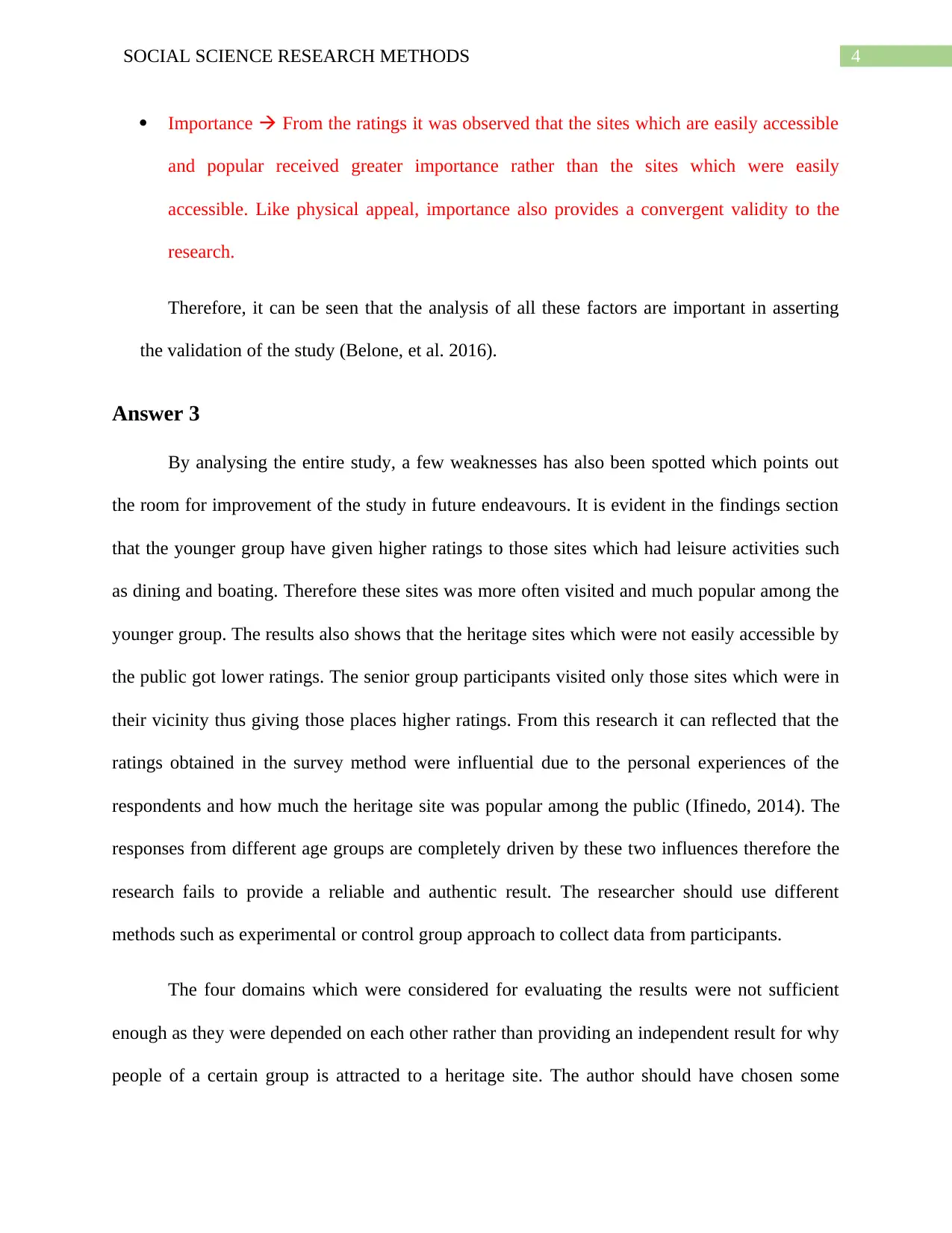
4SOCIAL SCIENCE RESEARCH METHODS
Importance From the ratings it was observed that the sites which are easily accessible
and popular received greater importance rather than the sites which were easily
accessible. Like physical appeal, importance also provides a convergent validity to the
research.
Therefore, it can be seen that the analysis of all these factors are important in asserting
the validation of the study (Belone, et al. 2016).
Answer 3
By analysing the entire study, a few weaknesses has also been spotted which points out
the room for improvement of the study in future endeavours. It is evident in the findings section
that the younger group have given higher ratings to those sites which had leisure activities such
as dining and boating. Therefore these sites was more often visited and much popular among the
younger group. The results also shows that the heritage sites which were not easily accessible by
the public got lower ratings. The senior group participants visited only those sites which were in
their vicinity thus giving those places higher ratings. From this research it can reflected that the
ratings obtained in the survey method were influential due to the personal experiences of the
respondents and how much the heritage site was popular among the public (Ifinedo, 2014). The
responses from different age groups are completely driven by these two influences therefore the
research fails to provide a reliable and authentic result. The researcher should use different
methods such as experimental or control group approach to collect data from participants.
The four domains which were considered for evaluating the results were not sufficient
enough as they were depended on each other rather than providing an independent result for why
people of a certain group is attracted to a heritage site. The author should have chosen some
Importance From the ratings it was observed that the sites which are easily accessible
and popular received greater importance rather than the sites which were easily
accessible. Like physical appeal, importance also provides a convergent validity to the
research.
Therefore, it can be seen that the analysis of all these factors are important in asserting
the validation of the study (Belone, et al. 2016).
Answer 3
By analysing the entire study, a few weaknesses has also been spotted which points out
the room for improvement of the study in future endeavours. It is evident in the findings section
that the younger group have given higher ratings to those sites which had leisure activities such
as dining and boating. Therefore these sites was more often visited and much popular among the
younger group. The results also shows that the heritage sites which were not easily accessible by
the public got lower ratings. The senior group participants visited only those sites which were in
their vicinity thus giving those places higher ratings. From this research it can reflected that the
ratings obtained in the survey method were influential due to the personal experiences of the
respondents and how much the heritage site was popular among the public (Ifinedo, 2014). The
responses from different age groups are completely driven by these two influences therefore the
research fails to provide a reliable and authentic result. The researcher should use different
methods such as experimental or control group approach to collect data from participants.
The four domains which were considered for evaluating the results were not sufficient
enough as they were depended on each other rather than providing an independent result for why
people of a certain group is attracted to a heritage site. The author should have chosen some

5SOCIAL SCIENCE RESEARCH METHODS
other independent factors which would determine why a site is significant to a particular
individual.
The rating method used in quantitative analysis is not appropriate to calculate the results.
The authors should have used structured questions to measure a person’s knowledge, memory,
perceptions relating to physical appeal and significance of a site.
other independent factors which would determine why a site is significant to a particular
individual.
The rating method used in quantitative analysis is not appropriate to calculate the results.
The authors should have used structured questions to measure a person’s knowledge, memory,
perceptions relating to physical appeal and significance of a site.
⊘ This is a preview!⊘
Do you want full access?
Subscribe today to unlock all pages.

Trusted by 1+ million students worldwide
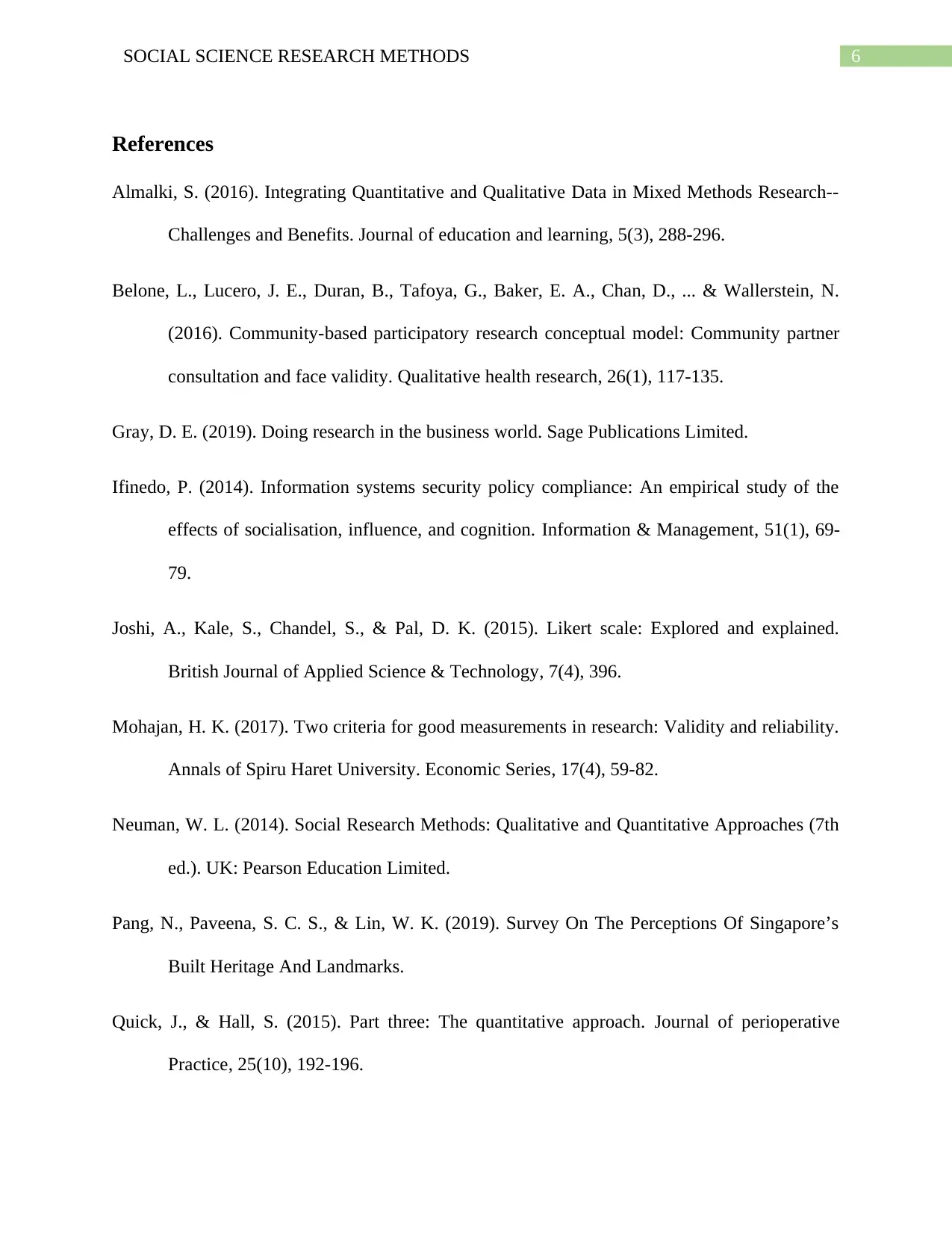
6SOCIAL SCIENCE RESEARCH METHODS
References
Almalki, S. (2016). Integrating Quantitative and Qualitative Data in Mixed Methods Research--
Challenges and Benefits. Journal of education and learning, 5(3), 288-296.
Belone, L., Lucero, J. E., Duran, B., Tafoya, G., Baker, E. A., Chan, D., ... & Wallerstein, N.
(2016). Community-based participatory research conceptual model: Community partner
consultation and face validity. Qualitative health research, 26(1), 117-135.
Gray, D. E. (2019). Doing research in the business world. Sage Publications Limited.
Ifinedo, P. (2014). Information systems security policy compliance: An empirical study of the
effects of socialisation, influence, and cognition. Information & Management, 51(1), 69-
79.
Joshi, A., Kale, S., Chandel, S., & Pal, D. K. (2015). Likert scale: Explored and explained.
British Journal of Applied Science & Technology, 7(4), 396.
Mohajan, H. K. (2017). Two criteria for good measurements in research: Validity and reliability.
Annals of Spiru Haret University. Economic Series, 17(4), 59-82.
Neuman, W. L. (2014). Social Research Methods: Qualitative and Quantitative Approaches (7th
ed.). UK: Pearson Education Limited.
Pang, N., Paveena, S. C. S., & Lin, W. K. (2019). Survey On The Perceptions Of Singapore’s
Built Heritage And Landmarks.
Quick, J., & Hall, S. (2015). Part three: The quantitative approach. Journal of perioperative
Practice, 25(10), 192-196.
References
Almalki, S. (2016). Integrating Quantitative and Qualitative Data in Mixed Methods Research--
Challenges and Benefits. Journal of education and learning, 5(3), 288-296.
Belone, L., Lucero, J. E., Duran, B., Tafoya, G., Baker, E. A., Chan, D., ... & Wallerstein, N.
(2016). Community-based participatory research conceptual model: Community partner
consultation and face validity. Qualitative health research, 26(1), 117-135.
Gray, D. E. (2019). Doing research in the business world. Sage Publications Limited.
Ifinedo, P. (2014). Information systems security policy compliance: An empirical study of the
effects of socialisation, influence, and cognition. Information & Management, 51(1), 69-
79.
Joshi, A., Kale, S., Chandel, S., & Pal, D. K. (2015). Likert scale: Explored and explained.
British Journal of Applied Science & Technology, 7(4), 396.
Mohajan, H. K. (2017). Two criteria for good measurements in research: Validity and reliability.
Annals of Spiru Haret University. Economic Series, 17(4), 59-82.
Neuman, W. L. (2014). Social Research Methods: Qualitative and Quantitative Approaches (7th
ed.). UK: Pearson Education Limited.
Pang, N., Paveena, S. C. S., & Lin, W. K. (2019). Survey On The Perceptions Of Singapore’s
Built Heritage And Landmarks.
Quick, J., & Hall, S. (2015). Part three: The quantitative approach. Journal of perioperative
Practice, 25(10), 192-196.
Paraphrase This Document
Need a fresh take? Get an instant paraphrase of this document with our AI Paraphraser
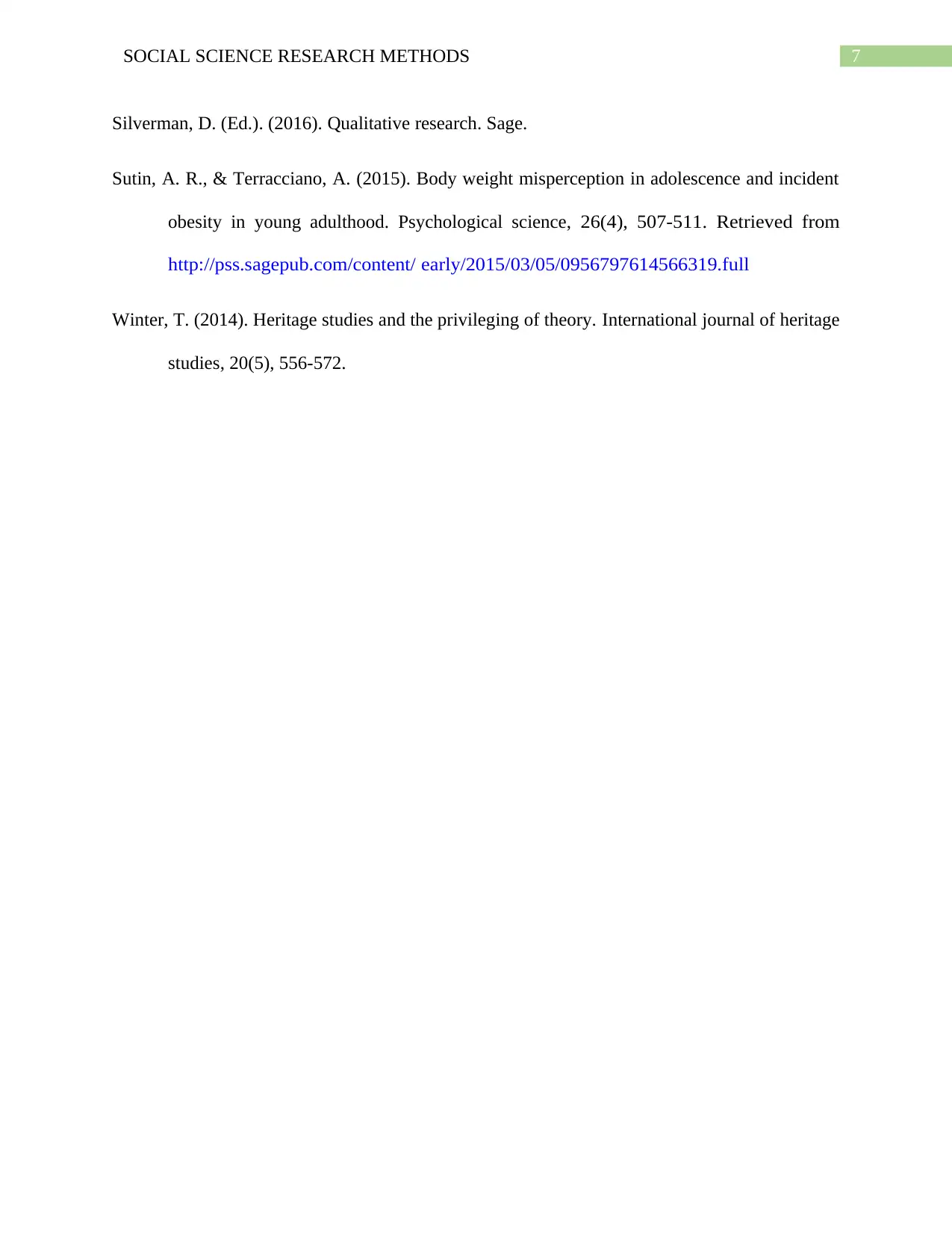
7SOCIAL SCIENCE RESEARCH METHODS
Silverman, D. (Ed.). (2016). Qualitative research. Sage.
Sutin, A. R., & Terracciano, A. (2015). Body weight misperception in adolescence and incident
obesity in young adulthood. Psychological science, 26(4), 507-511. Retrieved from
http://pss.sagepub.com/content/ early/2015/03/05/0956797614566319.full
Winter, T. (2014). Heritage studies and the privileging of theory. International journal of heritage
studies, 20(5), 556-572.
Silverman, D. (Ed.). (2016). Qualitative research. Sage.
Sutin, A. R., & Terracciano, A. (2015). Body weight misperception in adolescence and incident
obesity in young adulthood. Psychological science, 26(4), 507-511. Retrieved from
http://pss.sagepub.com/content/ early/2015/03/05/0956797614566319.full
Winter, T. (2014). Heritage studies and the privileging of theory. International journal of heritage
studies, 20(5), 556-572.
1 out of 8
Related Documents
Your All-in-One AI-Powered Toolkit for Academic Success.
+13062052269
info@desklib.com
Available 24*7 on WhatsApp / Email
![[object Object]](/_next/static/media/star-bottom.7253800d.svg)
Unlock your academic potential
Copyright © 2020–2025 A2Z Services. All Rights Reserved. Developed and managed by ZUCOL.





